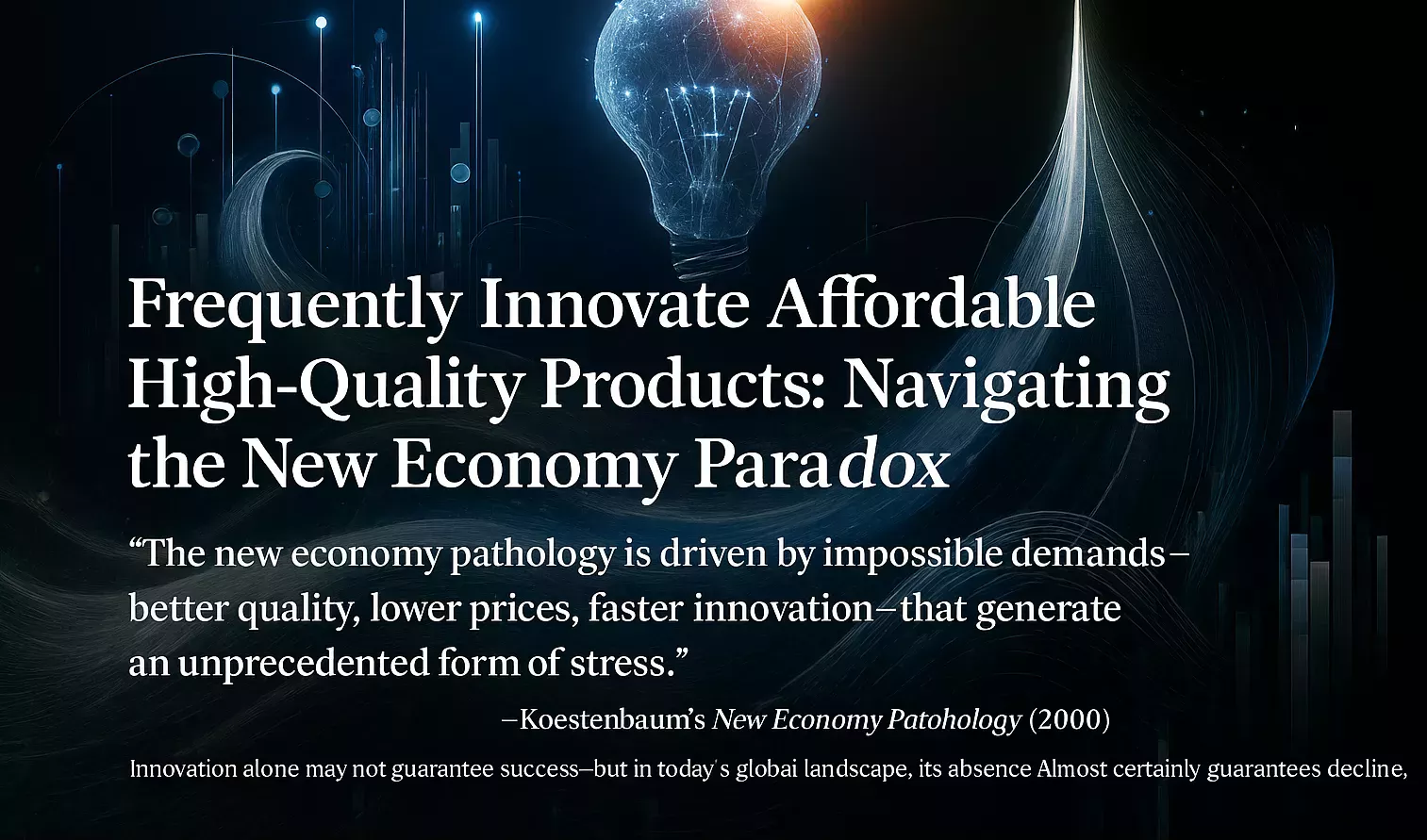Frequently Innovate Affordable High-Quality Products: The Modern Innovation Challenge in Navigating the New Economy Paradox
By TMCG Strategic Research/John G. Igitt, D.Eng, MBA
This article draws on Peter Koestenbaum’s concept of the “New Economy Pathology” and Clayton Christensen’s innovation theories — including Disruptive Innovation and Jobs to Be Done — to explore how firms can respond to the growing pressure to deliver better quality, lower prices, and faster innovation. It forms part of TMCG’s Insight Report series on modern innovation strategy and capability development.
“The new economy pathology is driven by impossible demands—better quality,
lower prices, faster innovation—that generate an unprecedented form of
stress.”
— Peter Koestenbaum (2000), The Journal for Quality and Participation
Introduction: The Paradox at the Heart of Modern Strategy
In the 21st century, firms face a seemingly paradoxical imperative: to deliver higher-quality products, at lower prices, with greater frequency of innovation…
Innovation as the Core Driver of Economic Profit
Clayton Christensen framed innovation as the ultimate enabler of growth…
The Strategic Tension: Why This Is So Difficult
The “triple constraint” that underpins Koestenbaum’s diagnosis can be
visualized as follows:
– Better Quality → Enhanced design, durability, functionality
– Lower Price → Lean cost structures, global sourcing, process optimization
– Faster Innovation → Shorter cycles, agile development, rapid prototyping
Most firms can achieve two of the three — but struggle to deliver all three
simultaneously without fundamentally reimagining their innovation models.
Strategic implication: Firms need to actively address the paradox of
simultaneous demands — better quality, lower prices, faster innovation — to
avoid being overwhelmed or fragmented by these pressures.
Why Prioritize Innovation Over Efficiency?
While operational efficiency sustains margins, it rarely fuels growth. Exploratory innovation, on the other hand, creates new markets, builds customer loyalty, and shields companies from obsolescence…
Implications for Global Competitiveness
Companies that resolve this paradox achieve measurable strategic gains:
1. Superior innovators consistently outperform their rivals in growth and
profitability
2. Strategic flexibility enables faster adaptation…
3. Robust innovation pipelines defend against disruption…
4. Differentiated offerings enhance global expansion…
5. Resilience is built through dynamic capabilities…
Resolving the Paradox: Strategic Models That Work
Firms that thrive amid Koestenbaum’s “pathology” don’t ignore the tension —
they design systems to transcend it:
– Strategic Ambidexterity
– Innovation Ecosystems
– Dynamic Capabilities
– Platform Thinking
Conclusion: Rethinking Growth in the Age of Impossibility
The New Economy Paradox is real — and intensifying. But it is not insurmountable…
Acknowledgment
AI Assistance Disclosure
This report was developed with the assistance of advanced AI tools,
including ChatGPT (OpenAI) and Claude (Anthropic), which supported our team
in expanding the research scope, synthesizing insights, and improving the
clarity and depth of our analysis.
Image: DALL-E:
This image was developed by TMCG using the DALL·E AI generation tool, based on original creative concepts and strategic direction provided by the TMCG team. While DALL·E assisted in producing the visual, the final content reflects TMCG’s proprietary design choices, innovation themes, and editorial curation.
TMCG’s consulting team thoroughly reviewed, validated, and approved all findings, conclusions, and strategic recommendations to ensure their accuracy, rigor, and relevance.
References (APA Style)
· Koestenbaum, P. (2000). The New Economy Pathology. The Journal for Quality and Participation, 23(4), 24–30.
· Koestenbaum, P. (2000, Jan 29). Do You Have the Will to Lead? Fast Company. https://www.fastcompany.com/38853/do-you-have-will-to-lead
· Christensen, C. M. (1997). The Innovator’s Dilemma. Harvard Business Review Press.
· Boston Consulting Group. (2023). The Most Innovative Companies: The New Rules of Innovation. https://www.bcg.com/publications/2023/most-innovative-companies
· Pisano, G. P. (2015). You Need an Innovation Strategy. Harvard Business Review, 93(6), 44–54.






